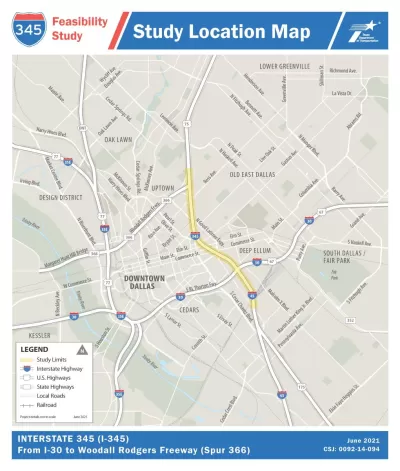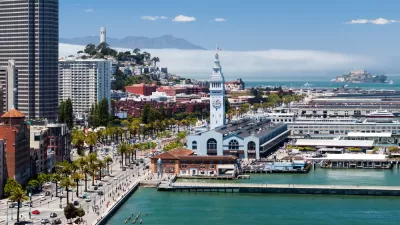Freeways have been removed before, but if the Texas Department of Transportation decides to tear down the I-345 freeway in Dallas, it would reflect a massive sea change in urban transportation planning.

"If you will excuse the pun, it looks like we may finally be approaching the end of the road — or at least the beginning of the end of the road — in deciding on a future for Interstate 345," writes Mark Lamster.
The Texas Department of Transportation (TxDOT) is wrapping up public comment on a feasibility study for the future of I-345 that includes an option to tear down the elevated freeway, reconnecting Downtown Dallas to the neighborhood of Deep Ellum.
As explained by Lamster, the feasibility study offers five possible alternatives: "repairing the road but leaving it unchanged; keeping it as an elevated highway but with a slimmer profile; depressing it into a trench (like U.S. 75) that can be bridged and decked; removing it altogether; and a hybrid combination of the trench and removal options."
According to Lamster, there was enough reaction to the feasibility study that TxDOT extended the deadline for public comment. We already know what advocates want—I-345 in Dallas made the 2019 "Freeways Without Futures" report published by the Congress for the New urbanism.
Discussions about what to do with the rapidly approaching obsolesce of the freeway's elevated structure has been ongoing since 2013, according to Lamster, and the tear-down alternative has emerged as a well considered planning alternative along the way:
The tear-out proposal, developed by the urban planner Patrick Kennedy, was a chance to re-knit the city while freeing up a huge swath of land for the kind of mixed-use, affordable development it desperately needed. Careful analysis of traffic patterns suggested that a new street system with boulevards and increased connectivity would avert serious congestion and massive delays, adding a mere five minutes to commutes.
Lamster voices his support for removal: "Of TxDOT’s five options, removal is the most logical, best option. Retaining the status quo at enormous cost would seem to be the worst possible choice."
FULL STORY: Dallas has 5 options for the future of I-345. Only one makes sense

Trump Administration Could Effectively End Housing Voucher Program
Federal officials are eyeing major cuts to the Section 8 program that helps millions of low-income households pay rent.

Planetizen Federal Action Tracker
A weekly monitor of how Trump’s orders and actions are impacting planners and planning in America.

Ken Jennings Launches Transit Web Series
The Jeopardy champ wants you to ride public transit.

Rebuilding Smarter: How LA County Is Guiding Fire-Ravaged Communities Toward Resilience
Los Angeles County is leading a coordinated effort to help fire-impacted communities rebuild with resilience by providing recovery resources, promoting fire-wise design, and aligning reconstruction with broader sustainability and climate goals.

When Borders Blur: Regional Collaboration in Action
As regional challenges outgrow city boundaries, “When Borders Blur” explores how cross-jurisdictional collaboration can drive smarter, more resilient urban planning, sharing real-world lessons from thriving partnerships across North America.

Philadelphia Is Expanding its Network of Roundabouts
Roundabouts are widely shown to decrease traffic speed, reduce congestion, and improve efficiency.
Urban Design for Planners 1: Software Tools
This six-course series explores essential urban design concepts using open source software and equips planners with the tools they need to participate fully in the urban design process.
Planning for Universal Design
Learn the tools for implementing Universal Design in planning regulations.
Ada County Highway District
Clanton & Associates, Inc.
Jessamine County Fiscal Court
Institute for Housing and Urban Development Studies (IHS)
City of Grandview
Harvard GSD Executive Education
Toledo-Lucas County Plan Commissions
Salt Lake City
NYU Wagner Graduate School of Public Service





























